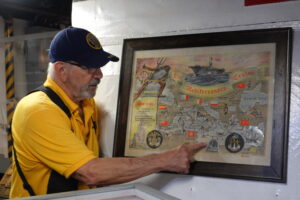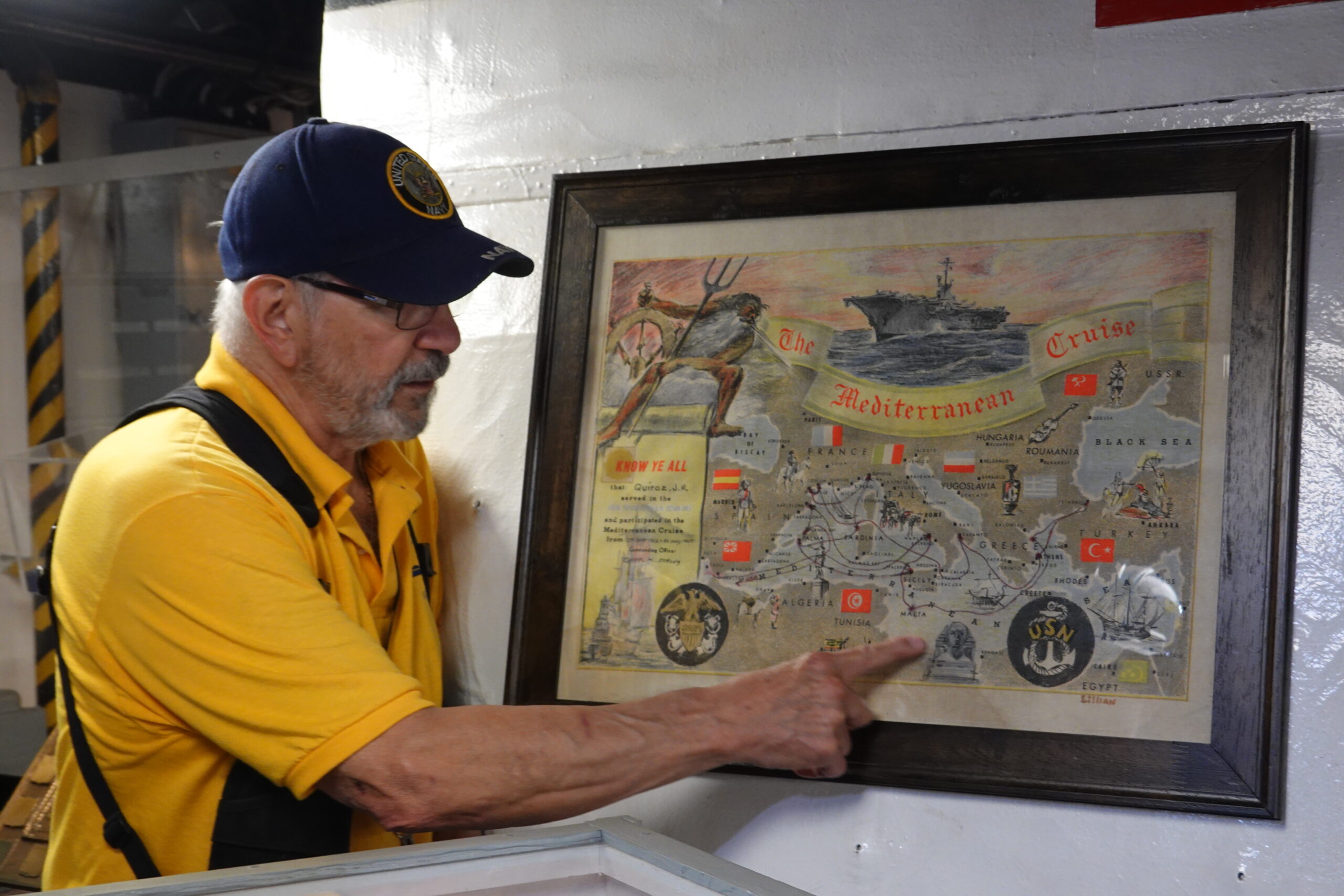Quite literally the “biggest’ tourist attraction in Corpus Christi is the World War II aircraft carrier USS Lexington. At 910 feet long, one can spend most of a day viewing the ship.
While most visitors opt for the self-guided tour which includes the flight deck, Sun News Austin takes you on the “Hard Hat” tour. Lasting 3-4 hours, this guided tour gets into the bowels of the ship, all the way down to the lowest deck. Here you can get up close with the boiler room and the engine room.
My tour guide was Joe Quiroz (lead photo), who served on a sister ship to the Lexington (the USS Shangri-La) during the Vietnam War period of the 1960s. He became an expert on the engine room, so his detailed description of how it all operated comes from real experience.
As a size comparison, the world’s longest cruise ship is 1,200 feet long, but that is now, in 2023. Back in 1943, when the Lexington was commissioned, it was impressively big and an engineering marvel. And even though the most modern US Navy ships are nuclear powered, they use that nuclear power to generate steam, so they are still really steamships! They are not that far different from the Lexington, and on the hard hat tour you can see the entire process from water being brought into the boilers, all the way to drive shafts that ultimately moved the propellers. Of course, the Lexington has been docked here since the 1990s, so it can’t move under its own power anymore. I’m going to quote here from Joe about how the ship got underway from port, and a problem he had dealing with alien life.
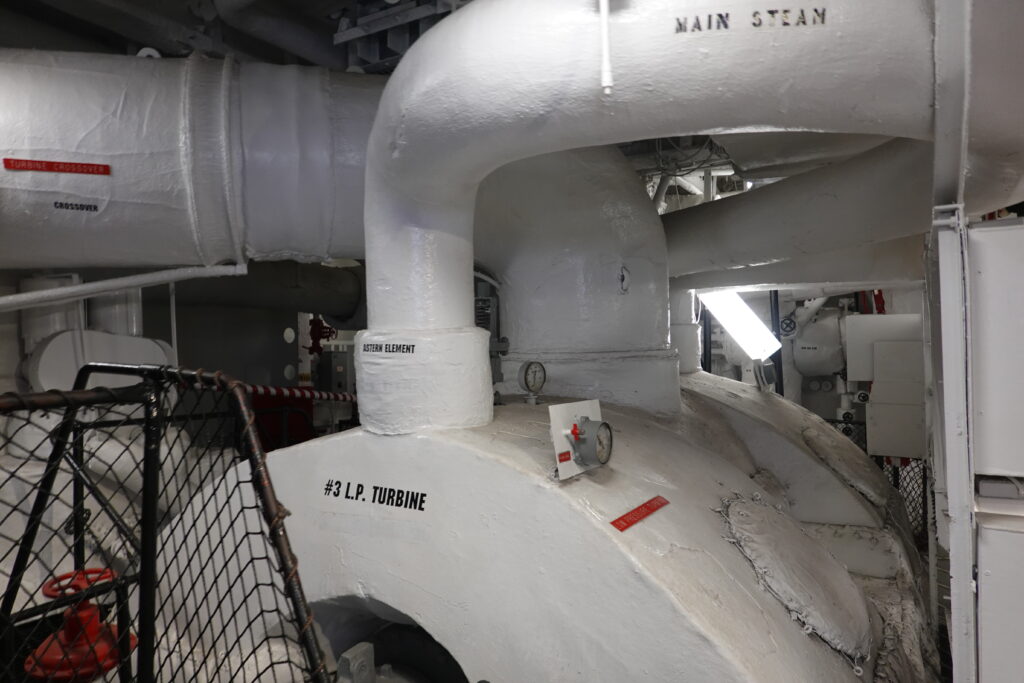 “This is No. 3 propellor shaft. Let’s say we’re going to leave Monday morning for Europe. We’re going to start bringing the guys aboard from the Naval Air Station. I’m ship’s company, I live and work here, this is my home. The other 1,800 men are at the Air Station, and we start bringing them aboard throughout the previous week. Above the Hangar desk is the Gallery deck, that’s where they live. So we wait for the Captain and he sets the speed. It’s always 1/3 ahead, never standard speed. I get the signal from the bridge, the bell rings. The flight needle is on stop; I unlock the wheels and the needle moves over to 1/3 ahead. I acknowledge (by turning a knob) and they see that I acknowledge on the bridge, and then I start opening the turbine valves to let the steam through the turbine.”
“This is No. 3 propellor shaft. Let’s say we’re going to leave Monday morning for Europe. We’re going to start bringing the guys aboard from the Naval Air Station. I’m ship’s company, I live and work here, this is my home. The other 1,800 men are at the Air Station, and we start bringing them aboard throughout the previous week. Above the Hangar desk is the Gallery deck, that’s where they live. So we wait for the Captain and he sets the speed. It’s always 1/3 ahead, never standard speed. I get the signal from the bridge, the bell rings. The flight needle is on stop; I unlock the wheels and the needle moves over to 1/3 ahead. I acknowledge (by turning a knob) and they see that I acknowledge on the bridge, and then I start opening the turbine valves to let the steam through the turbine.”
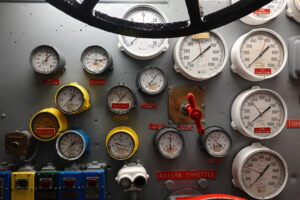 Joe then explained how the steam works. “If you boil one drop of water it’s going to expand 1,000 times from its original size. That’s steam overcoming atmospheric pressure. But I’m not boiling one drop of water, I’m boiling tons of water, and providing a path. I’ve piped that steam over here through the turbine; I’ve got to provide a vacuum of low pressure where the steam can flow down into. The condenser has two sides: the inlet seawater side and the steam side where we condense the water. I don’t want to mix either one of those or I’ll contaminate the whole system. If I get saltwater in the good water system an alarm will sound and I’ve got to shut this down and fix the leak. And that’s a shitty job!”
Joe then explained how the steam works. “If you boil one drop of water it’s going to expand 1,000 times from its original size. That’s steam overcoming atmospheric pressure. But I’m not boiling one drop of water, I’m boiling tons of water, and providing a path. I’ve piped that steam over here through the turbine; I’ve got to provide a vacuum of low pressure where the steam can flow down into. The condenser has two sides: the inlet seawater side and the steam side where we condense the water. I don’t want to mix either one of those or I’ll contaminate the whole system. If I get saltwater in the good water system an alarm will sound and I’ve got to shut this down and fix the leak. And that’s a shitty job!”
Joe said it only happened one time. “When I opened the condenser to go in, it was alien-land in there. All kinds of sea creatures. Amoebas were growing off the condenser wall. Barnacles, dead fish, sharks, crabs, sea snakes. We opened the man-way before we go in, stick our head in there and look around to see all of this marine life moving around in there. You’re afraid to go in there!” The commanding officer said “Go in there boy and clean it up!” They wouldn’t let me dump it into the bilge because it would plug it up, and it stinks to high heaven.” So he had to scoop it all up in buckets and toss it off the side.
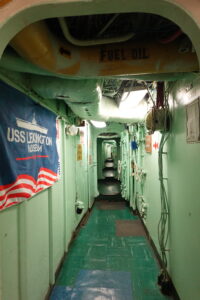 He explained that when he started losing vacuum, “I was heating my machine up, not cooling it which it was supposed to do down there. The tube sheet was covered in Sargasso seaweed. I opened this dry air suction; this takes the suction in the shell side of the condenser where the vacuum is. I want to start making a vacuum. I sealed both ends of the turbine with one pound of steam pressure because I don’t want to bring in any more atmospheric air. I next open a Venturi pipe, which is a pipe inside another pipe, so I have steam and a hole. So when I opened the steam valve it’s blowing inside and sucking in all the air around it, taking it out. We condense the steam, put it back in the system, and vent the air out. To maintain 28 inches of vacuum all the time.” Once the vacuum was established again, the saltwater was kept where it was supposed to be.
He explained that when he started losing vacuum, “I was heating my machine up, not cooling it which it was supposed to do down there. The tube sheet was covered in Sargasso seaweed. I opened this dry air suction; this takes the suction in the shell side of the condenser where the vacuum is. I want to start making a vacuum. I sealed both ends of the turbine with one pound of steam pressure because I don’t want to bring in any more atmospheric air. I next open a Venturi pipe, which is a pipe inside another pipe, so I have steam and a hole. So when I opened the steam valve it’s blowing inside and sucking in all the air around it, taking it out. We condense the steam, put it back in the system, and vent the air out. To maintain 28 inches of vacuum all the time.” Once the vacuum was established again, the saltwater was kept where it was supposed to be.
That’s just a snippet of what you learn on the hard hat tour, and even for those of us who are not engineers it is quite fascinating and well worth the effort to climb up and down many steep ladders.
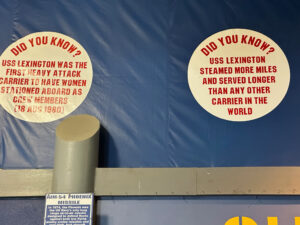 Once you are finished with the hard hat tour, you can take the self-guided tour at no additional charge. There are a host of displays to look at and a film to watch. Useful facts are posted in “Did You Know?” roundels all over; for example, the Lex has more sleeping space than the largest hotel in the world. The ship has a gift shop, and a place to eat.
Once you are finished with the hard hat tour, you can take the self-guided tour at no additional charge. There are a host of displays to look at and a film to watch. Useful facts are posted in “Did You Know?” roundels all over; for example, the Lex has more sleeping space than the largest hotel in the world. The ship has a gift shop, and a place to eat.
 Before boarding, look to the uppermost part of the ship (pictured here). There you will see a Japanese flag. It marks the location where a kamikaze plane hit the Lexington at a speed of 250 mph on Nov. 5, 1944, killing 40 crew and injuring 132.
Before boarding, look to the uppermost part of the ship (pictured here). There you will see a Japanese flag. It marks the location where a kamikaze plane hit the Lexington at a speed of 250 mph on Nov. 5, 1944, killing 40 crew and injuring 132.
To book the hard hat tour, plan in advance as it is only offered on select days at 9am. Regular visits do not have to be booked. A full list of options for visiting the Lexington can be found on the website: www.usslexington.com
Photos by C. Cunningham and M. Emanuele, copyright SunNewsAustin
Lead Photo: Joe pointing at a map showing his tour of duty in the Mediterranean, in the 1960s.
